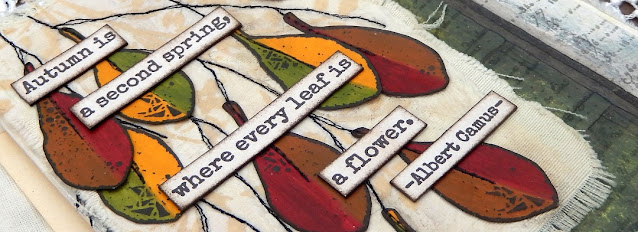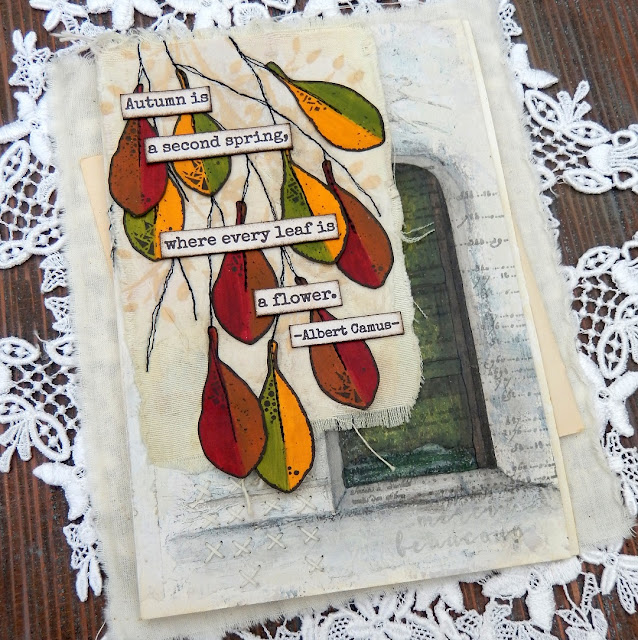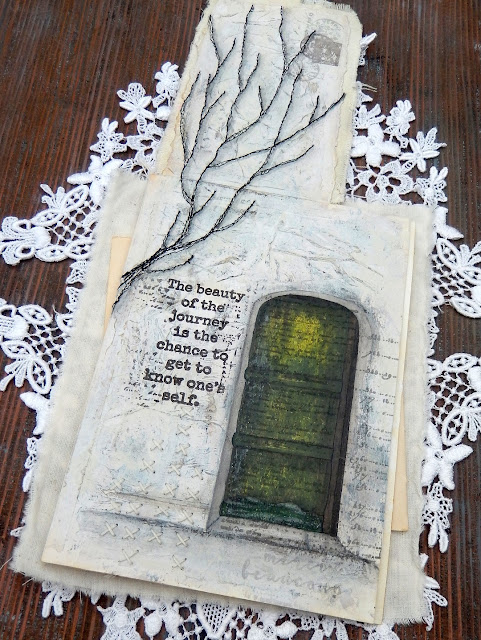2021 Topic 15: Journaling Gratitude
Have
you tried stitching on your projects? Jenny has several options for you
here, including a really fail-proof faux stitching one, that you can
hardly tell isn't real! With lots of ideas for layering and beautiful
paint effects, this flip up journal page will keep you engrossed for
quite a while!
~ Keren
~ Keren
Hi everyone, it's Jenny Marples (Pushing The Right Buttons) with
you today, and I'm here to share a journal page which celebrates the
Autumn and Winter seasons, helping to make me feel more grateful for
them along the way.
Inspired
by the beautiful needlework often seen in Keren Baker's work I've had a
go at 'drawing' with machine stitching as well as coming up with a way
of turning 'a negative into a positive' to create colourful Autumn
leaves with Courtney Franich's gorgeous stamps.
This
piece all started after an October morning walk where the leaves were
changing colour from their familiar Summer green to jewel-like shades of
yellow, red and brown. They brought to mind a photo of an old green
door I'd seen the previous day and an idea was sparked.
Wanting
to capture the visual magic of both the Autumn leaves and the door I
came up with a layout 'sketch' which involved adding a 'flip up' element
to a journal page using the smallest leaves from Courtney Franich's
stamp set ECF05.
The main journal page was already prepped with a scrap of book page and some white gesso. To create the flip up piece I took a blank index card torn along the edges and cut some fabric to a similar size with the idea of sticking those two together. A way of adding extra texture to the surface of all of these is to apply wrinkled tissue paper with some gel medium; once paint is added those wrinkles come to life. When dry the index card was stuck to the fabric and attached to the top of the journal page with masking tape.
Laying
down layers of paint that won't be totally visible in the end is key to
getting surfaces with a look of depth and interest (think Seth Apter's
incredible pieces as a perfect example of this). Adding a little Sand
PaperArtsy Fresco Finish Chalk Acrylic Paint with a spatula over the
crumpled tissue revealed the texture beneath: I avoided the area where
the door would eventually go.
The
doorway was drawn on the right side of the page to make sure part of it
would be visible beneath the leaves; by providing a 'sneak peek' at
what lies on the next page you encourage viewers to turn over (or in
this case flip up!) and see more.
When
it came to painting the door I found applying very thin layers with a
small spatula helped control the application and allowed lower layers to
show through - try scraping away some of the paint as well as adding
more and think about leaving lighter areas as 'highlights'. I chose to
use Guacamole, Toad Hall and Winter Green PaperArtsy Fresco Finish Chalk Acrylic Paints for this process with Hyde Park added over the kickboard at the bottom and French Roast used on the door frames.
You can 'shift' the colour and give the door a richer glow by painting on a very thin layer of the translucent Pumpkin Soup
PaperArtsy Fresco Finish Chalk Acrylic Paint over the top - that's the
beauty of having opaque, semi-opaque and translucent options. I added
dimension using Stone around the edge and stopped the door from 'floating' by drawing a smudged line of French Roast below it.
Going
back to the original sketch I'd drawn branches onto a piece of tissue
and liked the design. Rather than transfer it with carbon paper and risk
adding ink onto the fabric beneath I ran lines of gel medium along the
drawn lines on the reverse and stuck the tissue to the fabric.
Having
lines to machine stitch over helps immensely, and accuracy is
definitely discouraged because in that way your finished look echoes the
feel of delicate branches. You can see I carried the lines onto the
attached page too. Remember, underneath the tissue is another layer of
wrinkled tissue with gel medium and paint over it so it is now resistant
to water. That's important because it means you can use water on a thin
brush to help tear away the excess above.
At
the beginning I mentioned turning a negative to a positive - well here
goes. Courtney's leaf designs are solid so when stamped they cover up
what is below. I wanted the colour beneath to be visible so after
painting a strip of paper with Blood Orange and Toffee PaperArtsy Fresco Finish Chalk Acrylic Paints I clear embossed them before painting over the top with the French Roast. Once dry rub over the leaves with a dry cloth to remove the paint from the embossed areas and reveal the design in reverse.
Repeat with Pumpkin Soup, Hey Pesto and French Roast PaperArtsy Fresco Finish Paints for the second set of leaves.
If you want to eliminate the shine of the embossing powder cover the leaves with layers of PaperArtsy Fresco Finish Acrylic Matte Glaze.
Glue
the leaves onto the stitched branches using the sketch layout as a
guide. I realised that it would look better to echo that stitching down
the centre of the leaves but to run them through the machine at this
stage could risk tearing them; in future would opt do this while they
are still in situ on the painted strip. As the next best option I chose
to 'fake it', using a tracing wheel to add indentations and drawing on
the 'thread' with a narrow tipped black pen.
I
love adding stamped detail over the top of hand drawn images to add
extra interest; in this case I used the Courtney's script stamp from the
same set over the door using grey permanent ink to keep it subtle.
Adding words can help to convey the intentions of the page; this sentiment from Sara Naumann's ESN42
stamp set spoke to my recognition of the understanding that whilst
Autumn and Winter often fill me with a sense of sadness and dread these
seasons have their own beauty, helping to make me even more appreciative
of Spring and Summer. By stamping the words under the tree (in brown
permanent ink) also means they are hidden from view until the leaves are
'removed'/raised. From a design perspective they also help lead the eye
from the tree down to the door.
More words from Sara Naumann's ESN36 stamp set spoke to the beauty of the leaves seen on those October walks mentioned at the start of the post.
Here are some close ups of the finished journal page;
The hand stitching at the bottom of the page peeps out beneath the leaves.
Here
you can see how the stitching was extended down from the index card
flip onto the page underneath. Grey shadows were also added to one side
of the stitching to give the branches more of a sense of dimension.
I
stamped the postage stamp from Courtney's set in the top corner,
blotting the brown ink to knock it back a bit. I also chose to
over-stamp it with a postmark image from another of Courtney's stamp
sets, ECF06,
using grey ink. As an alternative you could re-use the circular element
of the postage stamp on either side of the brown stamp.
Can you spot the 'hidden' expression of gratitude beneath the door? These words came from Sara Naumann's ESN43 stamp set and were deliberately made barely visible with blotted grey ink.
With
lots of techniques and design ideas included in this post I hope you
feel excited to give them a go. Whether drawing (or even tracing) a
design on tissue and machine stitching over it or using crumpled tissue
under your layers of paint and sanding it back, there are lots of ways
to add texture to your journal pages. And if you have solid stamped
images that you'd prefer to see through try using clear embossing powder
as a paint resist.
Thank you so much for stopping by.
Jenny


















































3 comments:
Wonderful page. I love the hinged design, the colors, the stitching, and sentiments. Basically, I love the whole thing.
Brilliant! Thanks for sharing all your fabulous techniques.
WOW Jenny! The texture here is so incredible and I simply adore the flip up with the leaves, then the bare tree branch. Brilliant creativity and gorgeous results! xx, Autumn
Post a Comment